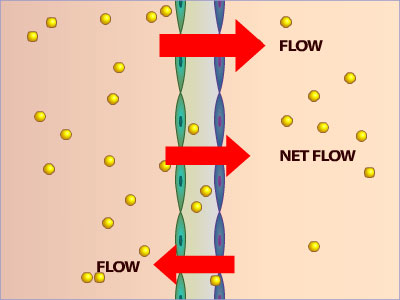The ability of ethanol to volatilize in the lungs makes it a good candidate to be detected with breathing devices such as the Breathalyzer™. The Breathalyzer™ test approximates a person’s blood alcohol concentration (BAC) because the concentration of alcohol vapor in the lungs is directly related to its concentration in the blood.
Although several devices can be used to test for alcohol in the breath, each one is based on a unique chemical property of alcohol and all are based on the central scientific principle that alcohol in the blood is in equilibrium with alcohol in the expired air.
How is equilibrium established?
Shortly after the first sip of beer, the concentration of ethanol in the blood exceeds the concentration of ethanol in the alveoli (which is zero).
Ethanol diffuses into the air sacs until the concentration in blood relative to that in air achieves a constant ratio.
Now, the two compartments are in equilibrium with one another.
- During equilibrium, molecules of ethanol may continue to move freely back and forth between the blood and the alveoli.
- But for each molecule that moves from the air sac back to the blood, another molecule moves from the blood to the air sac; so, no net movement of ethanol occurs across the membrane.
This equilibrium is dynamic because it can react to disturbances within either compartment. For example, when ethanol in the alveoli leaves the body in the breath, the ratio of ethanol concentration between the blood and the alveoli changes. To restore the ratio, more ethanol moves from the blood into the air sacs until the net flow of ethanol between the compartments is zero–equilibrium is restored.
 Figure 4.6 After drinking ethanol, it equilibrates between blood and the alveolus (left panel). With each exhalation, the equilibrium is disturbed, and more ethanol moves into the alveolus to reestablish the equilibrium (right panel).
Figure 4.6 After drinking ethanol, it equilibrates between blood and the alveolus (left panel). With each exhalation, the equilibrium is disturbed, and more ethanol moves into the alveolus to reestablish the equilibrium (right panel).